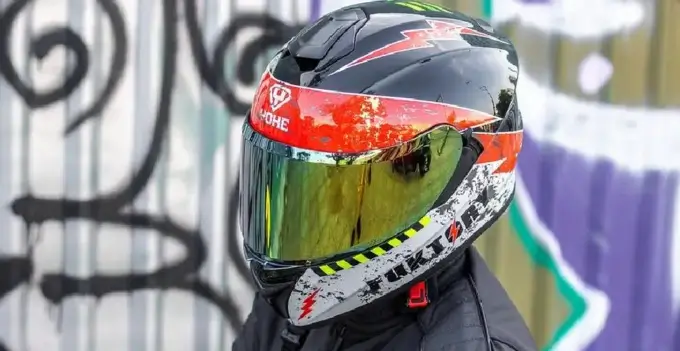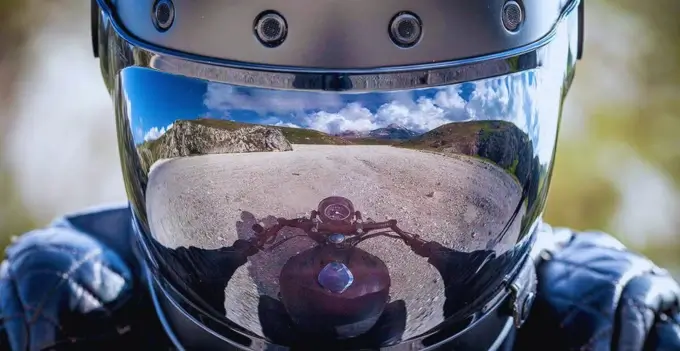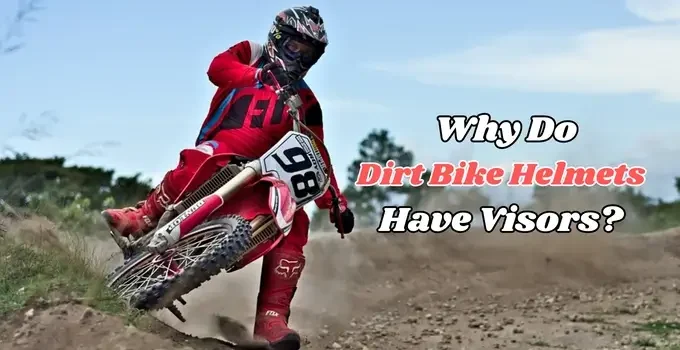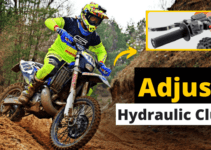As part of safety gear for off-road riding, a dirt bike helmet visor is crucial to wear on a bright day. But a question crossed the minds of some riders like me. Why do dirt bike helmets have visors? Why do they have odd shapes? Is it so to look fabulous?
Great questions.
Generally, a dirt bike helmet includes a visor, also named the peak, to protect dirt bikers from all types of flying objects, debris, and weather extremities experienced during a ride. It also protects from the sunlight by creating shade. It provides the rider with a defence against roosts and tree branches.
In short, motocross helmet visors contribute to both looking fabulous and protecting the dirt bike rider’s face from any possible danger.
Have you ever wondered why dirt bike and street bike helmets are so different? We’ll brief you with in-depth research on why.
Continue reading!
What is a Dirt Bike Helmet?
A dirt bike helmet is a specialized protective headgear for off-road dirt biking. It shields the rider’s head from potential impacts, falls, and debris encountered during adrenaline-fueled adventures on rough terrains. These helmets provide maximum protection, such as increased ventilation for optimal airflow and a lightweight design to minimize fatigue.
Why do dirt bike helmets have peaks? Unlike street bike helmets, dirt bike helmets have a visor or the peak covering the rider’s eyes. A visor protects the rider’s face from rocks, dirt and other flying debris on the trail. Dirt bike helmets are designed to provide minimal weight protection and good ventilation for off-road racing. They keep the rider’s head cool and ventilated.
Why Do Dirt Bike Helmets Have Visors?
The visor, a see-through face shield, is an optical polycarbonate shield on a helmet. Most people refer to the helmet with a plastic brim over the goggles, called a peak. Polycarbonate is preferred due to its impact resistance and good light transmissive properties. The primary purpose of a visor/peak is to protect the rider’s eyes from dirt and even bugs while driving.
Typically, the visor on a dirt bike helmet protects the rider from the unique off-road riding conditions, including debris, mud, tree branches, and protection against rain or sun.
If you’re new to dirt bike riding, you may wonder why dirt bike helmets have visors/peaks.
Dirt bike helmets have visors for the following purposes:
1. Roost
Roost is the spray of dirt, rocks, and debris kicked up by the rear wheel of a dirt bike while in motion. It happens to many riders during off-road riding.
When a rider accelerates, the spinning rear tire forcefully propels loose particles on the ground into the air, creating a rooster-tail-like effect. That airborne mixture of dirt and debris, forced behind the bike, is commonly known as “roost.”
The visor is a physical barrier, shielding the face and eyes from airborne dirt, rocks, and debris. The experienced riders will tell you the primary purpose of having a visor on your helmet.
Roost contains various objects, debris, dirt, etc., thrown up by a bike’s rear tire directly in front. Usually, if there’s a rider in front of you and spraying up roost, you can lean your head down to use the visor. Hence the visor shields your head and your face from potential injuries. It also prevents dirt from entering goggles.
Interesting Fact:
Roost is a common nickname for the sand, dirt, rocks, or mud thrown up by the rider’s rear wheel in front of you, resembling a rooster’s tail.
2. Weather Extremities
The visor of a dirt bike helmet acts like a cap or a hat. It can block direct sunlight and keeps the sun’s heat off your face. So, it keeps the irritating glare from the sun out of the rider’s eyes. If it rains during a ride, the visor will help to keep the rain out of your face and provide a clearer view.
Additionally, visors can help you stay safe and keep you focused on the track, even in bad weather conditions.
3. Tree Branches
When riding on a rough wooded trail, the branches can hit you in the face. The visor will deflect those thick branches away from your face and protect you from injury.
While riding through the wooded land, you must watch all the upcoming branches in your track. You need to adjust the visor low. Make sure to lower your head before hitting the units or tree brushes. If you don’t drop your head, the visor might break down in the branch.
Tip:
Wear goggles to protect your eyes and face from hitting smaller objects.
What are the Types of Visors?
Although visors may vary in style and shape, there’re two main types: built-in visors and detachable/removable visors.
1. Built-in Visors
A built-in visor is just that – it doesn’t move. Built-in bills are designed as permanent fixtures of dirt bike helmets. It also offers protection from dirt, debris or sunlight. They have a short visor, which protects them from crashes. The more extended visor might break during a hit, but the short visors don’t.
Ultimately, built-in visors protect riders from dirt, debris, and accidents.
It’s essential to recommend those adjustable visors for riding on challenging terrains or in bad weather conditions.

2. Detachable/Removable Visors
Detachable or removable visors are a type of visor that can be easily removed or attached to a dirt bike helmet as needed. These visors offer flexibility and versatility to riders to customize their helmet based on their specific riding conditions, preferences, or style.
Detachable visors may involve Snap-On buttons, screws, or other fastening systems, depending on the specific helmet design. When attached, the visor protects roost, debris, sunlight, and other elements encountered during off-road riding.
The main advantage of detachable visors is their adaptability. Riders can remove the visor when riding well-groomed tracks or during extreme weather conditions. Removing the visor can create a more streamlined helmet profile and reduce wind resistance.
Moreover, detachable visors offer the flexibility to swap out visors of different shapes, sizes, or colors to suit personal preferences. Riders can choose visors with various tints, anti-fog coatings, or other specialized features.
Here’re some types of detachable visors:
a. Tinted Visor:
Tinted visors are adjustable to reduce glare and shield the rider’s eyes from intense sunlight. This type of visor is made from plastic or polycarbonate. They feature a tinted or smoked lens that helps improve visibility in bright conditions without compromising safety. Tinted visors are particularly useful in desert or sunny environments.
b. Anti-Fog Visor:
Some visors have anti-fog properties or ventilation systems to prevent fogging, especially in colder or humid conditions. These visors ensure clear visibility, even when the rider is exerting themselves or riding in challenging weather conditions.
c. Drop-down Visor:
A drop-down visor is an adjustable visor. It is a retractable sun shield located inside the helmet. It allows riders to quickly lower or retract the visor to block out bright sunlight, reducing glare and enhancing visibility. It provides a convenient and integrated sun protection solution without needing separate sunglasses or tinted visors.
d. Clear Visor:
A clear visor is a transparent shield on a dirt bike helmet that offers unobstructed visibility, protecting the rider’s face and eyes from roost, debris, and wind during off-road riding. However, it doesn’t protect from the sun’s UV rays because it is clear.

How to Pick a Suitable Visor for Your Dirt Bike Helmet?
Which visor is best for your dirt bike helmet? Depending on the track or trail, picking a suitable visor is paramount. When choosing the correct visor for your dirt bike helmet, there’re several factors to consider.
Here’re some key points to help guide your decision:
1. Riding style compatibility:
Determine the primary purpose of the visor. Are you looking for sun protection, roost deflection, or both? Consider the specific needs of your riding style and the environmental conditions you frequently encounter.
Ensure that your visor is compatible with your dirt bike helmet model. Check for compatibility information the helmet manufacturer provides or consult their customer support if needed.
A built-in visor is a good choice if you want casual mountain biking. A removable visor is the better option for MX, single-track courses, rough terrains, or severer weather conditions. Because these visors will detach if caught in something, they prevent the rider’s head or neck from injury.

2. Visibility:
Opt for a visor that offers clear visibility without distortion. Look for visors made from high-quality materials that provide an unobstructed view and maintain visual clarity in various lighting conditions.
Clear visors offer the least protection but allow the most light during the day. In contrast, tinted visors provide some protection from the sun’s rays. Lastly, mirrored visors reflect sunlight away from your eyes, perfect for riding in bright conditions.
3. Fittings & Adjustments:
Adjustability will help you estimate how you feel at ease with your helmet as you try it on your riding activities. A poorly fitted helmet can be unsafe for you while riding.
Therefore, consider the adjustability options of the visor. Some visors are adjustable, allowing you to customize the position to suit your preference and riding conditions. Ensure the visor can be securely fastened to your helmet for a proper fit.
4. Quality and features:
Consider your additional features, such as anti-fog coatings, ventilation systems, or tinted options. These features can enhance your comfort and visibility during rides. Look for a worthwhile quality that has longevity.
Which type of visor is right for you? It’s up to you, depending on your riding conditions.
Recommended Helmets:
The Fly Racing Formula and Bell MX-9 Mips Helmet are the best for dirt bike riders.
The Benefits of a Visor on a Dirt Bike Helmet
The visor on a dirt bike helmet has several benefits that contribute to the rider’s comfort, safety, and overall riding experience. Here’re some key advantages of having a visor on a dirt bike helmet:
1. Protection from the sun
Sun causes a lot of discomfort while riding. It can make you feel overheated. The primary purpose of a visor is to protect your face from the glaring sun.
A visor can also protect your skin from the sun’s UV rays. It blocks out excessive sunlight, preventing it from obstructing the rider’s vision and allowing them to focus better on the trail or track.

2. Protection from flying debris
Another benefit that dirt bike helmets have visors is to protect the rider from flying dust and debris. One of the primary functions of a visor is to shield the rider’s face and eyes from roost, dirt, rocks, branches, and other debris that may be kicked up during off-road riding.
The visor acts as a barrier, deflecting these objects away and preventing them from directly hitting the rider’s face, reducing the risk of injury.
3. Protection from insects
The dirt bike helmets have visors to protect riders from insects like bugs. These insects can hit you in the face and eyes when riding at high speeds and cause injuries. A visor deflects these bugs and keeps them from hitting your face. While racing or riding on rough terrains, wearing a helmet with the correct visor is essential to keep yourself safe from insects.
4. Improved visibility
Many dirt bike riders wear goggles for eye protection and to avoid dust and debris. The visor on the helmet provides a secure and stable platform to mount and integrate the goggles, ensuring a proper fit and preventing them from slipping or getting displaced during rides.
Overall, the visor on a dirt bike helmet offers crucial protection, improves visibility, and enhances the riding experience. It is done by shielding the rider’s face from roost, debris, sunlight, and adverse weather conditions.
The Drawbacks of a Visor on a Dirt Bike Helmet
While visors on dirt bike helmets provide numerous benefits, it’s also important to be aware of potential drawbacks.
Here’re a few downsides of having a visor on a dirt bike helmet:
1. It can fog up
Fogging up is especially common in cold or humid weather. If your visor fogs up, you cannot see clearly, which can be dangerous.
2. It can be challenging to see through in low-light conditions.
A dark visor can make it difficult to see in low-light conditions, such as dusk or dawn. Visors can restrict the rider’s peripheral vision to some extent. The visor’s edges may obstruct the rider’s side vision. It’s essential to compensate for this limitation by increasing head movement to maintain situational awareness.
3. It can be difficult to remove
One potential drawback of some visors on dirt bike helmets is that they can be difficult to remove. It can be inconvenient when wanting to switch visors quickly or during cleaning. However, not all visors have this issue, and modern helmets often feature user-friendly attachment systems.
Can you put a face shield/peak on a dirt bike helmet?
Yes, putting a face shield on a dirt bike helmet is possible. However, it’s important to note that not all dirt bike helmets are designed to accommodate face shields.
Face shields, or full-face visors, provide additional protection by covering the entire face area. They offer benefits such as enhanced protection from roost, debris, wind, and sun, improved aerodynamics and reduced noise.
Face shields typically require specific mounting points and mechanisms on the helmet to ensure a secure and proper fit. Therefore, it is crucial to check the compatibility of your dirt bike helmet with face shields before attempting to install one.
Why don’t the dirt bike helmets have face shields? Many dirt bike helmets are designed to be used with goggles, not a face shield. It is because goggles provide better protection from dust, mud, and other debris that the wheels of the dirt bike can kick up. On the other hand, a face shield can easily fog up or get dirty, obstructing your vision and making it dangerous to ride.
Why do dirt bike helmets look different?
Dirt bike helmets serve a different purpose than motorcycle helmets. On-road riding is less physically demanding and faster than other off-road racing styles. We need different helmet designs to accommodate the needs of both riding styles.
Off-road riding tends to be more physically demanding and generates higher heat levels. Dirt bike helmets are designed to provide better airflow and cooling. They may have larger vents or specialized channels for improved air circulation and heat dissipation.
Dirt bike helmets often feature a longer visor or peak. The extended visor shields the rider’s eyes from the sun, reducing glare. It protects from roost, debris, and branches encountered during off-road riding.
Dirt bike helmets typically have a more pronounced chin bar than other types. This is because the chin bar helps to protect the rider’s face from impacts and debris.
Dirt bike helmets prioritize lightweight construction to reduce rider fatigue and enhance comfort during extended off-road rides.
Why do motocross helmets use goggles?
Many ATV and motocross helmets are designed as open-faced. This way, goggles are essential to protect the rider’s face due to the open-face design. But it’s not the only reason to use goggles for off-road riding.
A motorcycle helmet’s visor can’t protect the rider’s face and eyes from flying dust. However, goggles have thick foam-outlined padding, creating a tight seal. Therefore, it blocks most dust from entering the rider’s eyes.
The elastic strap keeps the goggles firmly against the rider’s face.
Final Words
After knowing all about dirt bike helmets, it’s your turn to buy the right one and consider this question again: “Why do dirt bike helmets have visors?”
Now you know that dirt bike helmet visors are essential because they protect your eyes from the wind, dirt, and debris while riding. They also help keep your eyes protected from UV rays. In addition, they protect your face from the massive dirt, weather extremities, tree brushes, and other flying debris on off-road biking activities.
Protect your head; wear a helmet with a visor!
Have a safe journey!
FAQs
When can you use a dirt bike helmet visor?
The visor is often called a face shield of the riders. It must be used while riding through rough, muddy terrain, wooded trails, or extreme weather conditions. Visor protects you from roost, tree branches, flying dirt and debris. Therefore, before going for a long ride, you must use a fit and suitable visor on your dirt bike helmet according to the trail conditions.
Why do dirt bike helmets have peaks?
The dirt bike helmets are made for adventurous off-road riding. A peak or visor on dirt bike helmets prevents rocks and other road debris from hitting you in the face. The visor protects from the sun’s harmful rays. It helps to shield the rider’s face from rain, snow, wind, and even flying insects, ensuring a more comfortable riding experience.
Can you wear a motocross/dirt bike helmet on the street?
Dirt bike helmets are designed to wear on off-road riding. They have features that make them more effective in that environment. A regular motorcycle helmet on the road will be more appropriate than a dirt bike helmet. Moreover, you can use a dual sport helmet too.
Is a dirt bike helmet visor necessary for trail riding?
Yes! A dirt bike helmet visor/peak is necessary for off-road trail riding. A visor provides primary protection against flying dirt, debris and bugs. It also protects you from rainwater entering your eyes and face. Therefore, you should use a dirt bike helmet with a visor to ensure your safety.







